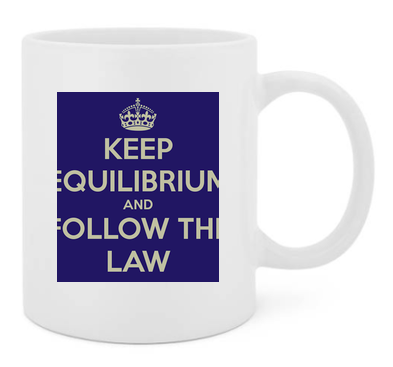17.1 Equilibrium law
Written specifically for students to provide help and support for the IB Diploma chemistry programme this page provides full coverage of the syllabus content of Topic 17.1 Equilibrium law. It encourages you to think critically and provides many questions with full worked answers so that you can monitor and improve your knowledge and understanding.

 Learning outcomes
Learning outcomes
After studying this topic you should be able to:
 Understand
Understand
- The equilibrium expression explains Le Chatelier’s principle when applied to changes in concentration.
- The position of equilibrium corresponds to a maximum value of entropy and a minimum in the value of the Gibbs free energy, i.e. at equilibrium ΔG is equal to zero.
- Both the Gibbs free energy change of a reaction and the equilibrium constant can be used to measure the position of an equilibrium reaction. They are related by the equation ΔG⦵ = − RT lnKc.
Apply your knowledge to:
- Solve problems involving homogeneous equilibrium using the expression for Kc.
- Use the relationship between ΔG⦵ and the equilibrium constant.
- Perform calculations using the equation ΔG⦵ = − RT ln Kc.
Relationships & vocabulary
Nature of science
In the IB guide the syllabus states that this topic provides an example of using quantitative reasoning. It claims that experimentally determined rate expressions for forward and backward reactions can be deduced directly from the stoichiometric
equations. However rate expressions cannot be deduced from stoichiometric equations they must be determined experimentally. Once the equilibrium expression is known, then it can be used to explain Le Chatelier's principle as applied to that particular reaction.
International-mindedness
For examples and links to International mindedness, Theory of knowledge, utilization etc. see separate page which covers all of Topics 7 & 17: Equilibrium.
Vocabulary
Gibbs free energy, ΔG
Learning slides
You can use this slide gallery for learning or for reviewing concepts and information. It covers all the key points in the syllabus for this sub-topic.
Something to think about
A simple question, which would seem to be exactly what this topic is about, might be:
What amount (in mol) of ethyl ethanoate will be formed in the equilibrium mixture if 2.0 mol of ethanoic acid and 1.0 mol of ethanol are reacted and allowed to reach equilibrium at 373K? The value for Kc at this temperature is 4.

According to the IB you should be able to deduce the expression which will give you the answer. Assuming the amount is x mol and the volume remains constant then the expression is 4 = x2 / ((2.0 – x) x (1.0 – x)) = x2 / (x2– 3x + 2) i.e. 3x2 – 12x + 8 = 0. Solving this gives the answer 0.85 mol. However the syllabus clearly states that you are not required to solve quadratic equations so a question such as this cannot be asked in the IB exam.
One area of mathematics that you can be asked about which is relevant to this topic is to solve problems using the equation ΔG = − RT lnKc. In question 5 in the short-answer questions below you are asked to calculate Kc for the equilibrium reaction between ethanol and ethanoic acid to form water and ethyl ethanoate using thermodynamic data. If the data from the IB data booklet is used the answer comes out to be 13.2 at 298 K. This is significantly higher than the usual value of 4 that is quoted in the literature. From a Nature of Science point of view it is worth considering why there is this difference. The reason is due to the logarithmic factor in the equation. A very small difference in the ΔG value makes a huge difference to the answer. Using the ΔH and ΔS values in the data booklet give a ΔG value of − 6.4 kJ mol-1. If values from other data sources are used this value can change and it only needs to change by 3 kJ mol−1 so that it becomes − 3.4 kJ mol−1 to give the correct answer of 4 for Kc.
Test your understanding of this topic
(Note that your teacher may have restricted your access to some or all of these questions and worked answers if they are going to use them as a class test or set them as an assignment.)
For ten 'quiz' multiple choice questions with the answers explained see MC test: The equilibrium law.
For short-answer questions see Equilibrium law questions.
More resources
1. A resource made for Advance Placement (AP) chemistry but it takes you through the whole of equilibrium ending up with solving some problems.
2. An example of a gaseous equilibrium calculation. Could be worth showing as the chemistry is very much on the IB syllabus but of course the mathematics for obtaining the final solution, which involves solving a quadratic equation, is not.

 IB Docs (2) Team
IB Docs (2) Team 




















